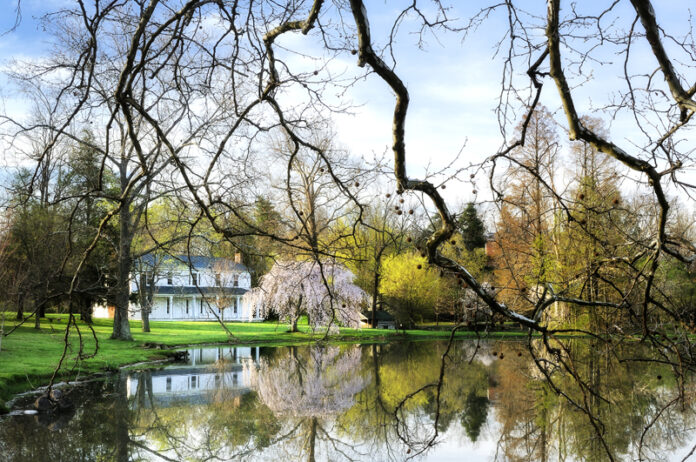
Virginia Tech celebrated the restoration and reopening of its oldest structure, “Solitude” last week – part of which was built circa 1801. In 1872, the $21,250 purchase of Solitude and about 250 surrounding acres provided a home for the “Virginia Agricultural and Mechanical College,” the land-grant institution now known as Virginia Tech.
“As a land-grant university, part of our mission is to engage with the region,” said Sue Ott Rowlands, dean of the College of Liberal Arts and Human Sciences, who along with Provost Mark McNamee was one of several speakers at the formal re-opening last week. “Solitude represents our ability to connect to the past, to families that originally settled this area, and to families that currently are still living and working here.”
Solitude served as a college infirmary from 1882 to 1886. Faculty members lived in it for about the next 60 years. It briefly was a clubhouse for returning World War II veterans, who lived in trailers surrounding the building, while attending what then was called Virginia Polytechnic Institute. At that time, dances regularly were held in Solitude’s two front parlors. In the 1960s and 1970s, Solitude was used by the Hokie Club.
Academic programs started using the building in 1974. For some time, Solitude housed a human nutrition and food laboratory and interior design studios and offices. Its last occupant was the Appalachian Studies Program, which has returned and is now housed on the second floor. Professor Bert Rodriguez of the College of Architecture and Urban Studies, who specializes in historic preservation, also has an office there.
“Solitude stands as a material witness to many important chapters in the history of southwestern Virginia and of Appalachia in particular,” Rodriguez said.
The building’s front parlor on the ground floor eventually will be outfitted with reproductions of historical furniture “to make it evocative of what it looked like in 1872,” said Anita Puckett, an associate professor who directs the Appalachian Studies Program. The rest of the first floor will be decorated with furnishings in keeping with the historic nature of the building. One exhibit room on the first floor contains materials from the Earl Palmer Appalachian Photograph and Artifact Collection and a piece of furniture that was in the house before it was sold to the college by Col. Robert Preston.
3North, an architectural firm from Richmond that specializes in historic preservation, designed the restoration. South End Construction of Roanoke repaired the exterior. Snyder and Associates of Blacksburg handled the interior. Extensive repairs were made to the foundation. New electrical, plumbing, and heating systems were installed. Problems with the roof, chimney, and siding were also addressed.
Solitude is listed on the National Register of Historic Places. The building is also a Virginia Historic Landmark. It has been enlarged several times, but initially was a frontier-style log cabin.
Most of the original structure was covered up during various additions, but some original logs are visible inside the building’s basement, said university Capital Project Manager Bruce Ferguson.
“In the 1850s, modifications to the house gave it the Greek Revival look that is generally how we see it today, though I believe a few additional, minor changes were made in the 1870s” Ferguson said.
Located by the Duck Pond in one of the most scenic spots on campus, Solitude is sometimes referred to as the university’s “home place.”
Elizabeth Fine, a professor and former director of the Appalachian Studies Program, worked on several grants and fundraising activities that provided restoration money. Her office was in Solitude in the mid-1990s, before the building was closed pending repairs.
“It’s a perfect place to highlight the Appalachian heritage of the region, and it’s so beautiful,” she said of Solitude.
Several parking lots located near Solitude are available to those with faculty/staff parking permits or visitors who pick up free parking passes at the Visitor Information Center, located on Southgate Drive and open weekdays from 8 a.m. to 5 p.m. Visitor passes may also be obtained from the Virginia Tech Police Station, located on Sterrett Drive, outside of the Visitor Information Center hours.

